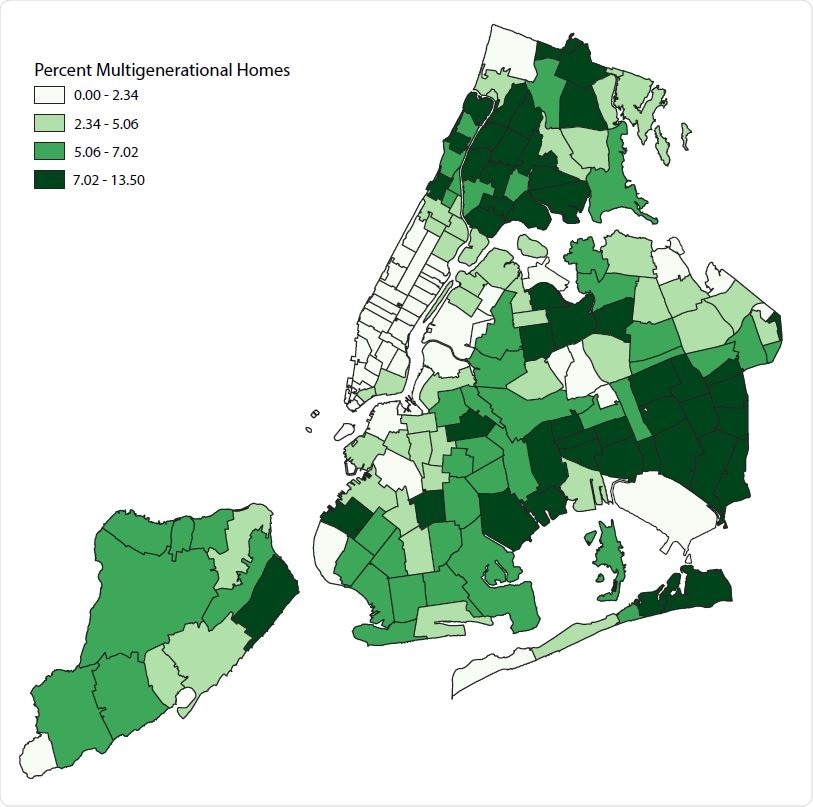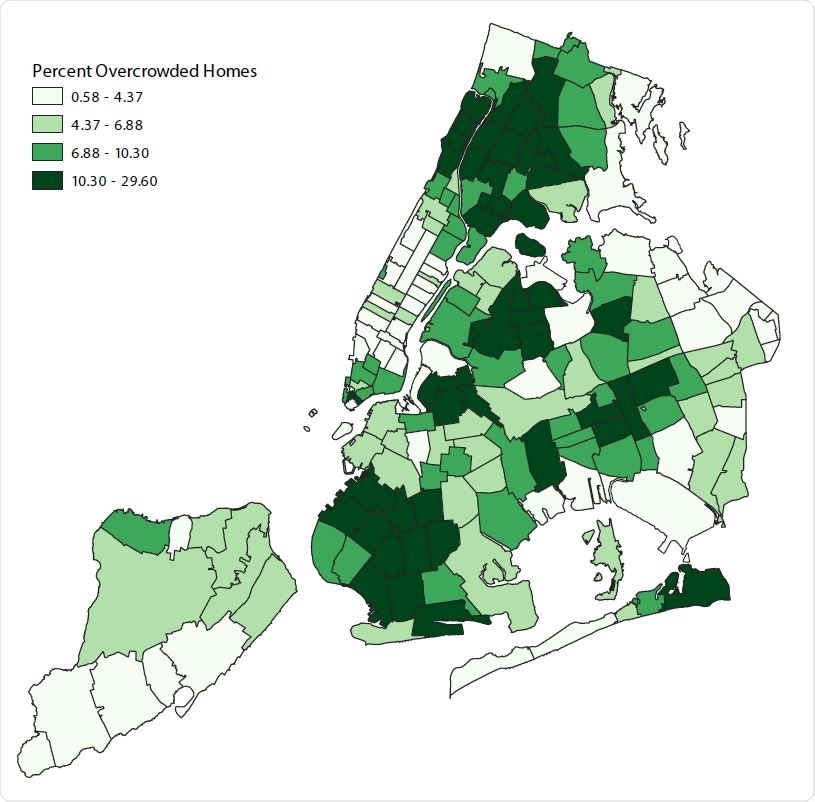Social distancing measures in public places decrease the risk of the severe acute respiratory syndrome coronavirus 2, the pathogen responsible for the coronavirus disease (COVID-19) pandemic. However, while social distancing may be effective in public places, people who live in overcrowded or multigenerational households are at a higher risk of exposure.
Researchers at the Weill Cornell Medical College aimed to determine the role of overcrowded households as a risk factor for COVID-19. The study's objective, which appeared in the medRxiv* pre-print server, was to examine the link between overcrowded and multigenerational households and COVID-19 in New York City.
Disparities in minority populations
The COVID-19 pandemic has exposed the marked health-related disparities in minority populations in the United States. These individuals are at a higher risk of severe illness caused by SARS-CoV-2. Studies have shown differences in COVID-19 testing, deaths, and disease between non-Hispanic Whites, non-Hispanic Blacks, and Hispanic Americans in both the health and community settings.
Other studies demonstrate that socioeconomic factors may play an imperative role in the risk of being infected with severe acute respiratory syndrome coronavirus 2 (SARS-CoV-2). These factors may also heighten the risk of death related to COVID-19.
These populations usually live with other families in a household. Thus, the role of overcrowding and household composition on the transmission of SARS-CoV-2 remains unclear. Data shows, however, that proximity to infected individuals and concentration of inoculum may play a vital role in acquiring the virus and the severity of the illness.
Overcrowded or multigenerational households
In the current study, the researchers investigated whether ZIP code tabulation areas (ZCTA) with a higher percentage of overcrowded or multigenerational households could be a risk factor for severe COVID-19.

Distribution of New York City ZIP code tabulation area (ZCTA) by a) suspected COVID-19 cases in March 1-30 2020; and b) overcrowded housing and c) multigenerational housing in 2018

 This news article was a review of a preliminary scientific report that had not undergone peer-review at the time of publication. Since its initial publication, the scientific report has now been peer reviewed and accepted for publication in a Scientific Journal. Links to the preliminary and peer-reviewed reports are available in the Sources section at the bottom of this article. View Sources
This news article was a review of a preliminary scientific report that had not undergone peer-review at the time of publication. Since its initial publication, the scientific report has now been peer reviewed and accepted for publication in a Scientific Journal. Links to the preliminary and peer-reviewed reports are available in the Sources section at the bottom of this article. View Sources
To arrive at the study findings, the team performed a Bayesian ecological time series analysis at the ZCTA level in NYC to evaluate whether households that are overcrowded or have multigenerational members were independently tied to higher suspected COVID-19 case rates.
Overcrowded households were defined as the proportion of the estimated number of housing units with more than one occupant per room. In contrast, multigenerational households were defined as the estimated percentage of residences occupied by a grandparent and a grandchild less than 18 years old.

Unadjusted and predicted trends in suspected COVID-19 cases per 10,000 population in March 1-30 2020 by a) percentage of multigenerational households, and b) percentage of overcrowdedness, both in quartiles
The team's final model controlled ZCTA-level sociodemographic factors, the prevalence of clinical conditions associated with COVID-19 severity, and spatial clustering. The sociodemographic factors include median income, the White race, essential workers, and poverty status, while clinical conditions include hypertension, obesity, coronary heart disease, diabetes, asthma, chronic obstructive pulmonary disease (COPD), and smoking status.

Percent Overcrowded Homes
The team found 39,923 suspected severe COVID-19 cases across 173 ZCTAs in New York City between March 1 and March 30, 2020. The adjusted COVID-19 case rates heightened by 67 percent in ZCTAs for overcrowdedness and increased by 77 percent for those living in multigenerational housing.
"We found that ZCTAs with higher proportions of overcrowded and multigenerational households were associated with increased rates of suspected severe COVID-19 cases, after accounting for both socioeconomic factors which may increase the risk of infection with SARS-CoV-2, and clinical factors which may lead to more severe COVID-19 disease," the team concluded in the study.
Study results show a relationship between COVID-19 case rates and area-level measures of overcrowded and multigenerational housing, illustrating socioecological mechanisms that explain observed inequities in COVID-19 related outcomes. This shows the racial or ethnic differences in mortality and morbidity in COVID-19 patients.
Further, the team revealed that at the beginning of New York's COVID-19 wave suggests that lockdown-related school and business closures were linked to adverse consequences for people living in areas with high levels of household crowding and multigenerational households.

 This news article was a review of a preliminary scientific report that had not undergone peer-review at the time of publication. Since its initial publication, the scientific report has now been peer reviewed and accepted for publication in a Scientific Journal. Links to the preliminary and peer-reviewed reports are available in the Sources section at the bottom of this article. View Sources
This news article was a review of a preliminary scientific report that had not undergone peer-review at the time of publication. Since its initial publication, the scientific report has now been peer reviewed and accepted for publication in a Scientific Journal. Links to the preliminary and peer-reviewed reports are available in the Sources section at the bottom of this article. View Sources
Journal references:
- Preliminary scientific report.
Ghosh, A,, Venkatraman, S., Soroka, O, et al. (2021). Association between overcrowded households, multigenerational households, and COVID-19: a cohort study. medRxiv. https://doi.org/10.1101/2021.06.14.21258904, https://www.medrxiv.org/content/10.1101/2021.06.14.21258904v1
- Peer reviewed and published scientific report.
Ghosh, A.K., S. Venkatraman, O. Soroka, E. Reshetnyak, M. Rajan, A. An, J.K. Chae, et al. 2021. “Association between Overcrowded Households, Multigenerational Households, and COVID-19: A Cohort Study.” Public Health 198 (September): 273–79. https://doi.org/10.1016/j.puhe.2021.07.039. https://www.sciencedirect.com/science/article/pii/S0033350621003097?via%3Dihub.